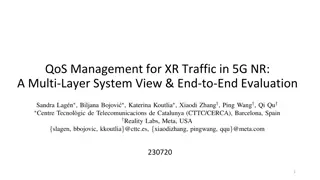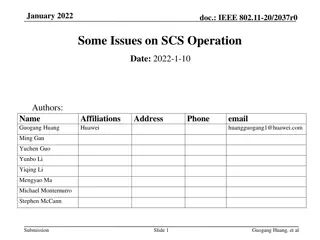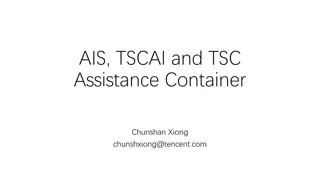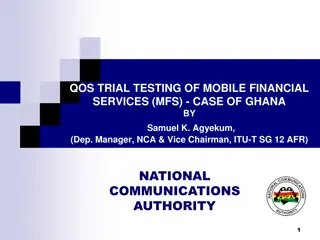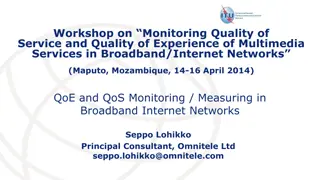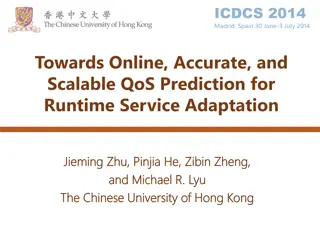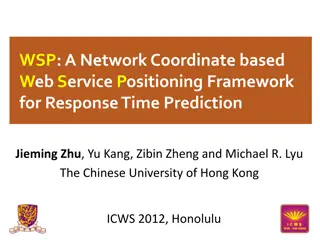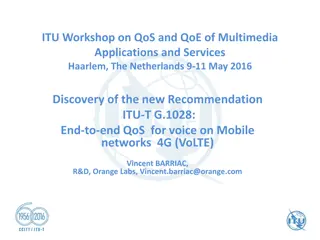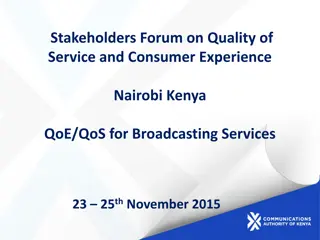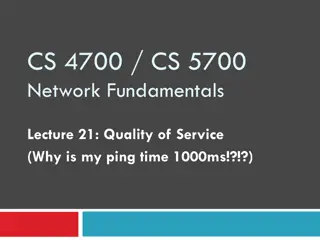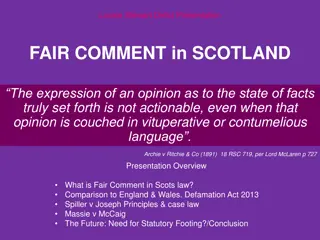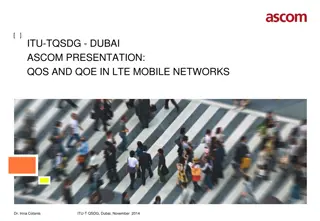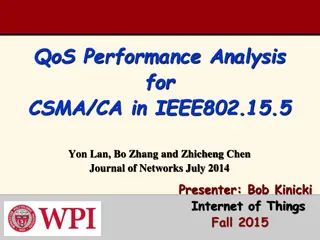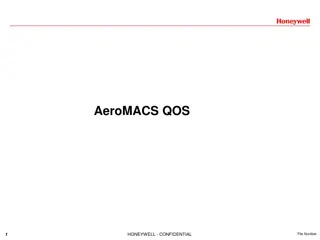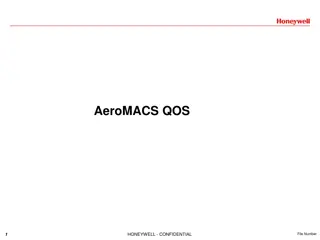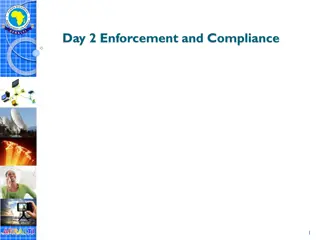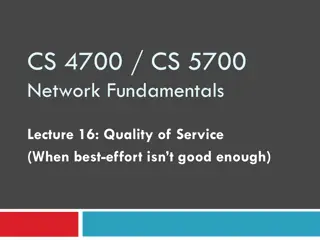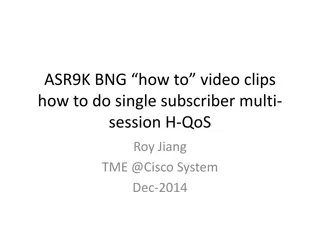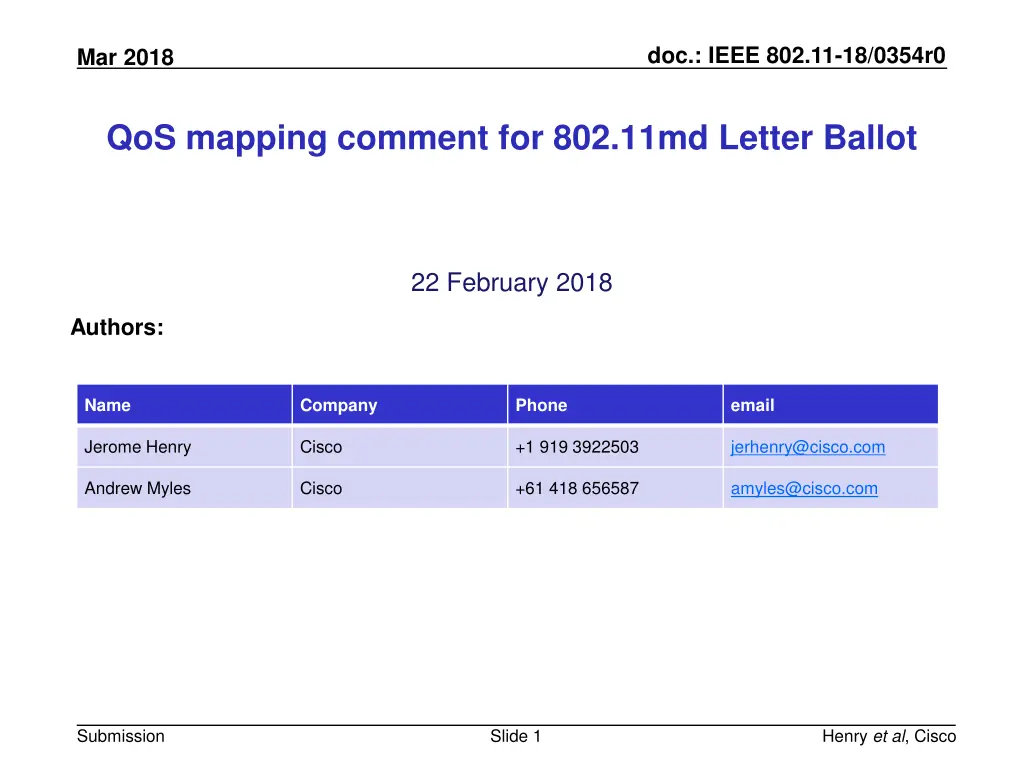
Improving QoS Mapping for IEEE 802.11 Networks
Enhance Quality of Service (QoS) mapping for IEEE 802.11 networks by updating DSCP to UP mapping in accordance with current specifications and practices. The existing mapping in IEEE 802.11-2016 is out of sync with industry consensus, necessitating a revised approach to ensure alignment with RFC standards and optimize end-to-end QoS intent across multi-hop networks.
Download Presentation

Please find below an Image/Link to download the presentation.
The content on the website is provided AS IS for your information and personal use only. It may not be sold, licensed, or shared on other websites without obtaining consent from the author. If you encounter any issues during the download, it is possible that the publisher has removed the file from their server.
You are allowed to download the files provided on this website for personal or commercial use, subject to the condition that they are used lawfully. All files are the property of their respective owners.
The content on the website is provided AS IS for your information and personal use only. It may not be sold, licensed, or shared on other websites without obtaining consent from the author.
E N D
Presentation Transcript
doc.: IEEE 802.11-18/0354r0 Mar 2018 QoS mapping comment for 802.11md Letter Ballot 22 February 2018 Authors: Name Company Phone email Jerome Henry Cisco +1 919 3922503 jerhenry@cisco.com Andrew Myles Cisco +61 418 656587 amyles@cisco.com Submission Slide 1 Henry et al, Cisco
doc.: IEEE 802.11-18/0354r0 Mar 2018 The DSCP to UP mapping in 802.11-2016 should be updated to match current specification & practice A mapping is required to map end-to-end QoS intent based on DSCP to a UP suitable for use over 802.11 QoS mapping general principle 802.11-2016 defines an example DSCP to 802.11 UP mapping in 802.11-2016 Annex R 802.11 QoS mapping situation The mapping in 802.11-2016 Annex R is inconsistent with current specification & practice 802.11 QoS mapping problem 802.11-2016 should be updated with a revised DSCP to 802.11 UP/AC mapping in Table R-2 802.11 QoS mapping revision Submission Slide 2 Henry et al, Cisco
doc.: IEEE 802.11-18/0354r0 Mar 2018 A mapping is required to map end-to-end QoS intent based on DSCP to a UP suitable for use over 802.11 QoS is an end-to-end concept across an entire multi-hop network DSCP is a commonly agreed upon mechanism in IP networks to communicate global QoS intent for a packet as it traverses a multi-hop network There are 64 QoS labels possible with DSCP 802.11 User Priority (UP) is used to represent the QoS intent of a packet when it is transmitted over an 802.11 link There are 8 QoS labels possible with 802.11e UP A mapping is thus required between DSCP and 802.11 UP labels, that translates the end-to-end QoS intent into a suitable 802.11e UP label It is vital that the 802.11 UP label should properly represent the end-end QoS intent on the local 802.11 link, and not contradict it Submission Slide 3 Henry et al, Cisco
doc.: IEEE 802.11-18/0354r0 Mar 2018 802.11-2016 defines an example DSCP to 802.11 UP mapping in 802.11-2016 Annex R R.3.3 Example of QoS mapping from different networks Table R-2 (Example Enterprise DSCP to UP/AC mapping) shows an example mapping based on application classes defined in IETF RFC 4594. Mapping between DSCP and UP can be done using Exception fields or by range. The use of DSCP Exception fields will map a DSCP to a UP according to Table R-2 (Example Enterprise DSCP to UP/AC mapping) . Submission Slide 4 Henry et al, Cisco
doc.: IEEE 802.11-18/0354r0 Mar 2018 The mapping in 802.11-2016 Annex R is inconsistent with current specification & practice Industry (in IETF) has spent many years developing consensus for QoS specification & practice with RFC 8325 representing current common ground with respect to DSCP to UP mappings for Wi-Fi The mapping in 802.11-2016 Table R-2 has diverged from the consensus for QoS specification and practice in recent years Application Class naming in Table R-2 contradicts the commonly accepted industry classifications defined by RFC 4594 The mapping from DSCP to 802.11 UP and AC in Table R-2 contradicts the latest industry agreement documented in RFC 8325 Submission Slide 5 Henry et al, Cisco
doc.: IEEE 802.11-18/0354r0 Mar 2018 Industry (in the IETF) has spent many years developing consensus for QoS specification & practice Some relevant IETF RFCs include: RFC 2474 - Definition of the differentiated services field (DS field) in the IPv4 and IPv6 headers RFC 3246 - An expedited forwarding PHB (obsoletes RFC 2598) RFC 3247 - Supplemental information for the new definition of the EF PHB (expedited forwarding per-hop behavior) RFC 2475 - An architecture for differentiated services RFC 2597 - Assured forwarding PHB group RFC 3260 - New Terminology and Clarifications for Diffserv (updates RFC 2474, RFC 2475 and RFC 2597) RFC 2983 - Differentiated services and tunnels RFC 4594 - Configuration Guidelines for DiffServ Service Classes RFC 3086 - Definition of differentiated services per domain behaviors and rules for their specification RFC 5865 - A differentiated services code point (DSCP) for capacity- admitted traffic (updates RFC 4542 & RFC 4594) RFC 3140 - Per hop behavior identification codes (obsoletes RFC 2836) Submission Slide 6 Henry et al, Cisco
doc.: IEEE 802.11-18/0354r0 Mar 2018 with RFC 8325 representing current common ground with respect to mappings for Wi-Fi Not all vendors apply the IETF recommendations for DSCP to traffic- class marking e.g., Microsoft suggests DSCP 40 for Voice e.g., Cisco recommends CS3 for Signalling etc. and as traffic mixes change, so do marking recommendations Even at Layer 2, recommendations are evolving e.g., UP 2 is not considered as best for BK anymore However, RFC 8325 represents the current common ground for marking in context of Wi-Fi Submission Slide 7 Henry et al, Cisco
doc.: IEEE 802.11-18/0354r0 Mar 2018 Application Class naming in 802.11-2016 Table R-2 contradicts the commonly accepted classifications Table R-2 classification (in priority order) RFC 4594 classification (in priority order) Network Control Network Control Telephony Telephony RT Interactive Signaling Multimedia Conference Multimedia Conferencing Signaling Real-Time Interactive Broadcast Video Multimedia Streaming Multimedia Stream Broadcast Video Low Latency Data Low Latency Data High Throughput Data OAM OAM High Throughput Data Standard Standard Low Priority/Background Low Priority Data /Background Note: naming & priority order differences shown in red Submission Slide 8 Henry et al, Cisco
doc.: IEEE 802.11-18/0354r0 Mar 2018 The DSCP to 802.11 UP and AC mapping in 802.11-2016 Table R-2 contradicts the latest industry agreement Latest industry agreement Application Class PHB Table R-2 mapping RFC 8325 mapping UP AC UP AC Network Control CS6 7 AC_VO 7 AC_VO Telephony EF 6 AC_VO 6 AC_VO Signaling CS5 5 AC_VI 5 AC_VI Multimedia Conferencing AF4x 5 AC_VI 4 AC_VI Real-Time Interactive CS4 6 AC_VO 4 AC_VI Multimedia Streaming AF3x 4 AC_VI 4 AC_VI Broadcast Video CS3 4 AC_VI 4 AC_VI Low Latency Data AF2x 3 AC_BE 3 AC_BE OAM CS2 3 AC_BE 0 AC_BE High Throughput Data AF1x 2 AC_BK 0 AC_BE Standard DS 0 AC_BE 0 AC_BE Low Priority Data /Background CS1 1 AC_BK 1 AC_BK Note: differences between Table R-2 and RFC 8325 highlighted in red Submission Slide 9 Henry et al, Cisco
doc.: IEEE 802.11-18/0354r0 Mar 2018 802.11-2016 should be updated with a revised DSCP to 802.11 UP/AC mapping in Table R-2 Application Class Per-Hop Behaviour (PHB) IEEE 802.11 User Priority Access Category Network Control CS6 7 AC_VO Telephony EF 6 AC_VO Signaling CS5 5 AC_VI Multimedia Conferencing AF4x 4 AC_VI Real-Time Interactive CS4 4 AC_VI Multimedia Streaming AF3x 4 AC_VI Broadcast Video CS3 4 AC_VI Low Latency Data AF2x 3 AC_BE OAM CS2 0 AC_BE High Throughput Data AF1x 0 AC_BE Standard DS 0 AC_BE Low Priority Data /Background CS1 1 AC_BK Note: differences between old and new Table R-2 highlighted in red Submission Slide 10 Henry et al, Cisco

